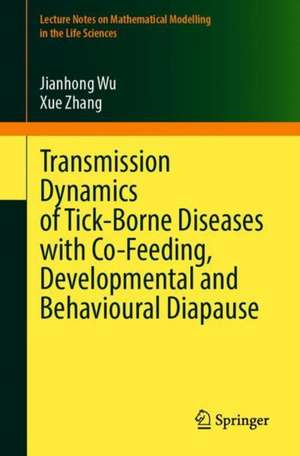Transmission Dynamics of Tick-Borne Diseases with Co-Feeding, Developmental and Behavioural Diapause: Lecture Notes on Mathematical Modelling in the Life Sciences
Autor Jianhong Wu, Xue Zhangen Limba Engleză Paperback – 14 oct 2020
The ultimate aim of this project is to develop a general qualitative framework leading to tick-borne disease risk predictive tools and a decision support system.
The target audience is mathematical biologists interested in modelling tick population dynamics and tick-borne disease transmission, and developing computational tools for disease prevention and control.
Din seria Lecture Notes on Mathematical Modelling in the Life Sciences
-
 Preț: 340.61 lei
Preț: 340.61 lei - 15%
 Preț: 496.23 lei
Preț: 496.23 lei - 15%
 Preț: 703.85 lei
Preț: 703.85 lei - 15%
 Preț: 605.02 lei
Preț: 605.02 lei - 15%
 Preț: 422.82 lei
Preț: 422.82 lei - 15%
 Preț: 704.69 lei
Preț: 704.69 lei -
 Preț: 412.58 lei
Preț: 412.58 lei -
 Preț: 543.08 lei
Preț: 543.08 lei - 15%
 Preț: 643.95 lei
Preț: 643.95 lei - 15%
 Preț: 655.77 lei
Preț: 655.77 lei - 15%
 Preț: 474.31 lei
Preț: 474.31 lei - 18%
 Preț: 784.48 lei
Preț: 784.48 lei - 15%
 Preț: 586.64 lei
Preț: 586.64 lei - 15%
 Preț: 519.32 lei
Preț: 519.32 lei - 15%
 Preț: 587.85 lei
Preț: 587.85 lei -
 Preț: 401.42 lei
Preț: 401.42 lei -
 Preț: 456.48 lei
Preț: 456.48 lei -
 Preț: 379.09 lei
Preț: 379.09 lei - 20%
 Preț: 552.74 lei
Preț: 552.74 lei
Preț: 389.70 lei
Nou
Puncte Express: 585
Preț estimativ în valută:
74.58€ • 77.39$ • 62.33£
74.58€ • 77.39$ • 62.33£
Carte tipărită la comandă
Livrare economică 17-31 martie
Preluare comenzi: 021 569.72.76
Specificații
ISBN-13: 9783030540234
ISBN-10: 3030540235
Pagini: 160
Ilustrații: XIII, 160 p. 24 illus., 21 illus. in color.
Dimensiuni: 155 x 235 mm
Greutate: 0.45 kg
Ediția:1st ed. 2020
Editura: Springer International Publishing
Colecția Springer
Seria Lecture Notes on Mathematical Modelling in the Life Sciences
Locul publicării:Cham, Switzerland
ISBN-10: 3030540235
Pagini: 160
Ilustrații: XIII, 160 p. 24 illus., 21 illus. in color.
Dimensiuni: 155 x 235 mm
Greutate: 0.45 kg
Ediția:1st ed. 2020
Editura: Springer International Publishing
Colecția Springer
Seria Lecture Notes on Mathematical Modelling in the Life Sciences
Locul publicării:Cham, Switzerland
Cuprins
1. Ecology, Epidemiology and Global Public Health Burden of Tick-Borne Diseases.- 2. Deterministic Models and Temperature-Driven R0 Maps.- 3. Estimating Infection Risk of Tick-Borne Encephalitis.- 4. Structured Tick Population Dynamics.- 5. Infestation Dynamics and Tick-on-Host Distribution Pattern Formation.- 6. Oscillations Due To Diapause.- 7. Additional Topics for Future Studies.
Notă biografică
Jianhong Wu received his PhD in Applied Mathematics from Hunan University in 1987. He is currently a Distinguished Research Professor of Mathematics at York University, a Senior Canada Research Chair and an NSRRC/Sanofi Industrial Research Chair in Vaccine Mathematics.
Xue Zhang received her PhD in System Complexity Theory from Northeastern University in 2010. She is currently an Associate Professor of Mathematics at Northeastern University, and a Fellow of the Laboratory for Industrial and Applied Mathematics, York University.
Both authors have been involved in several interdisciplinary research projects on vector-borne disease prevention and control, and have been actively publishing on the subject of mathematical technologies for public health decision making.
Xue Zhang received her PhD in System Complexity Theory from Northeastern University in 2010. She is currently an Associate Professor of Mathematics at Northeastern University, and a Fellow of the Laboratory for Industrial and Applied Mathematics, York University.
Both authors have been involved in several interdisciplinary research projects on vector-borne disease prevention and control, and have been actively publishing on the subject of mathematical technologies for public health decision making.
Textul de pe ultima copertă
This monograph introduces some current developments in the modelling of the spread of tick-borne diseases. Effective modelling requires the integration of multiple frameworks. Here, particular attention is given to the previously neglected issues of tick developmental and behavioral diapause, tick-borne pathogen co-feeding transmission, and their interactions. An introduction to the required basics of structured population formulations and delay differential equations is given, and topics for future study are suggested. The described techniques will also be useful in the study of other vector-borne diseases.
The ultimate aim of this project is to develop a general qualitative framework leading to tick-borne disease risk predictive tools and a decision support system.
The target audience is mathematical biologists interested in modelling tick population dynamics and tick-borne disease transmission, and developing computational tools for disease prevention and control.
The ultimate aim of this project is to develop a general qualitative framework leading to tick-borne disease risk predictive tools and a decision support system.
The target audience is mathematical biologists interested in modelling tick population dynamics and tick-borne disease transmission, and developing computational tools for disease prevention and control.
Caracteristici
The first self-contained systematic introduction to the modelling of the spread of tick-borne diseases Focuses on the previously neglected issues of tick developmental and behavioral diapause, tick-borne pathogen co-feeding transmission, and their interactions Targeted towards disease prevention and control, encouraging the development of tick-borne disease risk predictive tools and a decision support system Includes the basics of structured population formulations and delay differential equations required for the appropriate models
